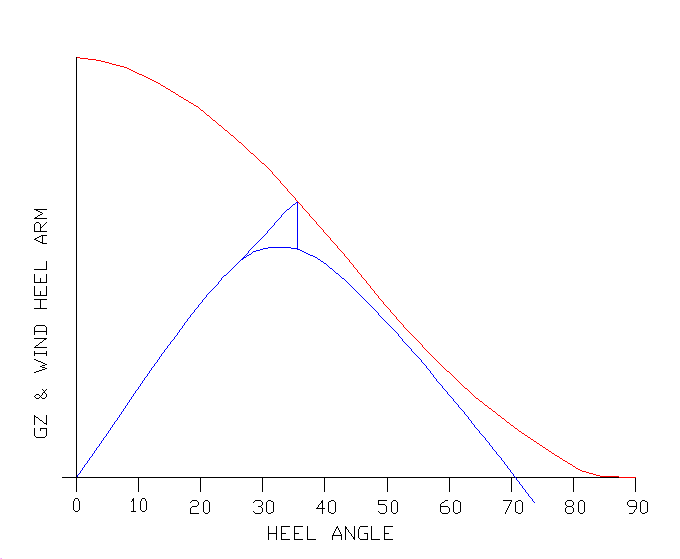
Why The Stability of Large (and small) Sailing Vessels Can Be Treacherous
Here, in blue, is the Righting Arm (stability) curve for a vessel. Note that the amount of stability as a function of ability to resist heeling forces increases at a steady rate for the first 15-16 degrees. It then begins to drop off after the deck edge goes under water. This curve shows a vessel with a range of stability of 85 degrees. Heel it to 84 degrees and let it go and it will return to upright. Heel it to 86 degrees and it will continue rolling over into a complete capsize even if the wind should suddenly stop.

The lower red curve represents the force of the wind and it can be seen to drop off as the vessel heels since less
sail area is exposed to the wind. A mathematical operation is performed on the curve so that it represents a wind
pressure on the zero axis of the graph. For a particular sail plan, there is a curve for each increment of wind
velocity and the point at which the red and blue curves cross indicates the heel angle that will be produced by
that wind pressure. It would be typical for a large sailing vessel to heel to her deck edge in a 20 mph wind. We
can therefore call the lower curve the 20 mph curve.
The upper red curve just touches the righting arm curve at 81 degrees and thereafter is above the righting arm
curve. This represents the minimum wind speed that could capsize the vessel with the same sail plan as in the lower
curve. The upright value is 8.35 times as great. Wind pressure at 20 knots is 1.64 pounds per square foot so the
wind pressure to capsize is 13.68 psf. The wind speed that could capsize the vessel, if prompt action is not taken,
is therefore 58 mph. This is a 38 mph increase.
Now, the vessel is converted in a way that adds weight to the rig and/or superstructure. To keep the calculations
simple, we’ll assume that ballast is removed to keep displacement constant. This could well be the case if there
is a Load Line or other draft restriction. Here is the new righting arm curve shown dotted.

The modified vessel, under the same sail plan at the same wind speed will now heel 1.5 degrees further in the same
wind velocity. Reefing just a bit sooner, not trimming quite as hard, changes in crew, and other factors can easily
mask this slight change in performance.
Now, however, let us look at the corresponding capsize wind heel curve for the modified vessel also shown dotted.
Although the range of positive stability has also changed only by what would seem a small amount, the capsize wind
heel curve now represents a wind pressure of only 4.68 times as great or 7.67 pounds. This corresponds to a wind
speed of 43 mph, an increase of only 23 knots.

With an almost insignificant change in the performance that would be perceived by the master and crew, the increase
in wind speed that the vessel can withstand without capsizing has been reduced by 39%. Since some reduction in
sail carrying power can be easily accommodated by minor changes in operation and may be considered a small price
to pay for greater utility in the absence of complete stability analysis, truly dangerous changes can be made to
the safety of a sailing vessel without it being at all apparent to the operator.
These relationships would also apply at the design stage. The original design might have been for the upper curve.
If, as usually happens, the weight and stability estimates turn out to be optimistic, the designer looking only
at performance in the the normal heel angle range might not see any need to modify the design. This is exactly
what happened in three of the four capsizes I studied where stability tests had been done.
The interesting righting arm curves are the ones that include the effect of bulwarks in the case of vessels with freeing port covers that act like one way valves.

To of the capsizes I studied had curves that looked like this. If the vessel was allowed to heel slowly and steadily
under wind pressure and water pour suddenly over the rail, the weight of the water would be sufficient to capsize
the vessel without any increase in wind speed if instant action were not taken.
It was pointed out to me that water had come over the rail of one of the vessels many times. However, waves rising
up and coming over the rail are a whole different issue. The buoyancy of the wave temporarily increases stability.
A motion roll down may also scoop up water without capsizing the vessel since it is not entirely due to wind force.
Experienced seaman are not necessarily trained to sort out the different seakeeping components involved. Large
vessels are seldom allowed to intentionally heel until the rail cap goes under.